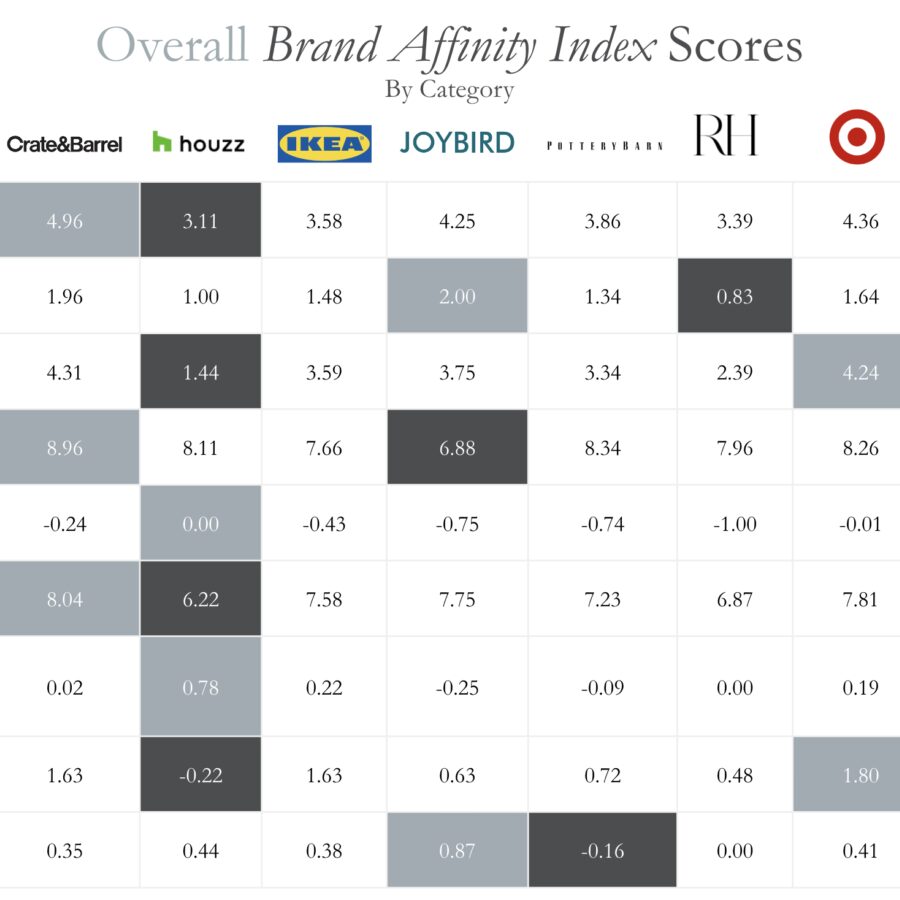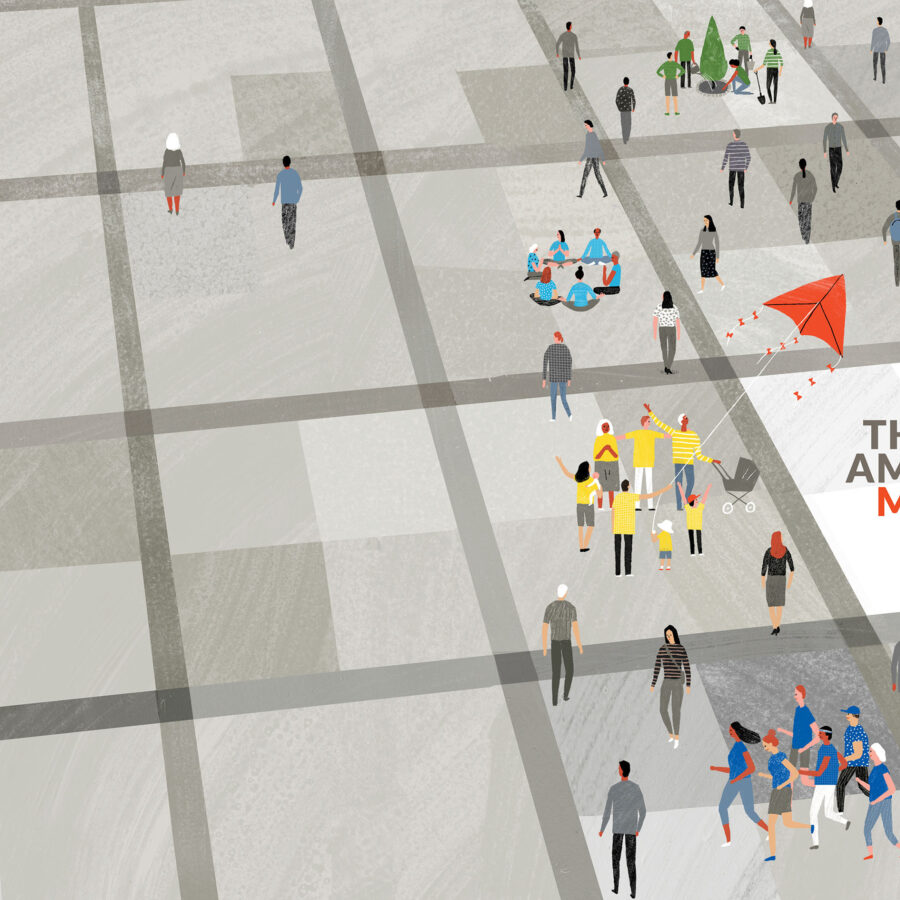
Brand Affinity Index
The Brand Affinity Index
The purpose with The Brand Affinity Index research program is to qualify and quantify how subsets of different consumers feel about various aspects of brand expression and branding.
This article addresses one big cultural phenomenon that all members of the New American Middle (NAM) oppose—bigness. The NAM universally questions—and increasingly opposes—big institutions and organizations, big government, big corporations, and big consumer brands. Any brand that approaches consumers as mere “transactional units,” or as simple statistics, is at risk of alienating their most loyal consumers and squandering the brand equity built over the earlier growth years.
Marketers have grown used to viewing consumers as two-dimensional objects, but with so many modern resources at every consumer’s fingertips, they—we—are the most well-rounded and well-informed population in the history of the world. True, we may not always be the most rational, or even the most predictable, when it comes to our purchasing habits, and our decisions are initiated by a kind of fuzzy logic that is backed up by a logical “reason” afterwards.
Like many consumer groups, the NAM rewards brands that reflect their values and help them furnish their lives with ideas and products that reinforce their preferred lifestyles. Understanding the NAM set of values is the key to reflecting their expectations back to them. Of course, the NAM understands that brands are moneymaking ventures, but as brand messaging loses its relevance—the vocabulary becoming more commercial than it is inclusive, more tell than show—the worm turns. They accept the role of customer but often chafe when clumped into a mass consumer group.
Women, the center of the NAM, can sniff out this change better than most; when they recognize they are being sold, they dig in their feet. Brands that double down with desperate discounts, flooding consumers’ email inboxes and retargeting them in intrusive ways, will no longer just be ignored—they will be actively punished. The brands “I used to love” will pay the price as their former loyalists become the wrong kind of influencers.
Ever since the 1960s, the American public has been confronted with an ongoing litany of governmental and corporate scandals. Dan Rather showed the ugly side of the Vietnam War—all guts, no glory. Nixon’s Watergate. Enron and healthcare fraud. The explosion of available information via the internet and social media gave everyone access to the world’s collective knowledge and history, and it also gave them a method to publish their own opinions about it. The public became aware of their own collective naivete.
Since 2015 there has been an entirely new level of influence and intrusion by large, powerful forces. Recalling Dickens’s opening lines from A Tale of Two Cities—“It was the best of times, it was the worst of times …”—we might conclude that we are still caught in that vise.
The best of times? We all have more choices and resources than ever before. It is empowering. It feels good. And it’s about time!
The worst of times? The world is complicated. The bad stuff all seems to intrude from the top down. It comes from big influences that we can neither understand nor control. Threats to our new freedoms come in the form of “big” influences. The NAM’s core values are impacted by social engineering that is not welcome. In fact, they seem pretty angry about it.


The last 50 years is nothing compared to the last 15. Here is the brief:
In 1970, futurist Alvin Toffler published his book Future Shock. In it, he predicted cultural paralysis resulting from stress, as well as disorientation resulting from “too much change in too short a period of time.” While society has made adaptations in ways Toffler did not predict, many of the effects of his predictions echo through to our current times. Fifty years is not a lot of time to process the cultural changes we have experienced.
The pace of change has dramatically quickened in the last 15 years. Screen time consumes much of our time. The world has never been a harmonious place, but very few people have the tools to sift through the quantity of information we are bombarded with every day. Being an informed voter has become a full-time job due to all the time it takes to sort through the lies, the fake news, the everchanging political agendas, and the emotions to find tangible facts.
The layers of betrayal, as outlined above, have become the cultural frame around the brand picture. It is the cultural dirt in which commercial brands are now planted. Brands are small potatoes compared to the grave consequences associated with the above mentioned, but when a brand is perceived as “too big to care,” it can easily be lumped together with the worst of them. Consumers cool off fast when they feel like their favorite brands over-promote and try to “sell” to them. The best brands are trusted metaphors for friendship, but when that friend tries to sell you some products from the latest multilevel marketing scheme they’ve roped themselves into, the friendship is over.
In August of 2018, Marketing Insider published an article titled, “Big-Brand Status No Longer Guaranteed Success Formula.” It begins by stating, “Between 2011 and 2016, large U.S. consumer companies lost an estimated $22 billion in sales to smaller brands.” The article includes suggestions for repairing the outdated mindset of many brands. Most of the answers have to do with reconnecting with brand purpose, and reconnecting with the consumer, in order to retain relevance. In other words, for a large brand to regain success, they have to think big and little. Grassroots. Bottom-up. Face-to-face.
It feels like a lot of work, retooling everything. And besides, isn’t the American dream to succeed by getting bigger and more powerful? Is “too big” even possible? When everything has gone well, and there is momentum, why would we do anything to slow the roll?
And yet, if we want to retain the true core of a brand, perhaps there might be a lesson in here somewhere.
Between 2011 and 2016, large U.S. consumer companies lost an estimated $22 billion in sales to smaller brands.
Marketing Insider
Women exert massive influence on the household spend, and yet the brands that expect women to buy their goods are male-dominated. Most ad agency copywriters and creative directors are male. Most execs in agencies are male. There is irony for you. Is it any wonder why brands have trouble earning her loyalty?
So, brand marketers are all caught in a quandary. Big success is achieved by working at a big scale. Shareholder value or investor returns are expected in the short term. Discounting, over-promotion, and the declining-price spirals are a result of being controlled by such short-term demands. Profitable brands retain customers by knowing them and providing relevancy that goes beyond lowest price. Achieving relevance takes multiple skill sets and reinvestment to define a repeatable process. It not only takes capital—it also requires talent. Be big and act small? It seems impossible.
Deep down, all consumers understand a brand needs to make a profit. It’s how they do it that is the issue. Unless brands are about something more than making money, if they stand for nothing else, they are just selling “stuff,” and as Marie Kondo has taught us, no one needs more “stuff.” The ocean is filling up with it. The NAM isn’t in the position to row out and pick up that plastic floating in the Pacific, but they can—and do—reuse and recycle. Environmental stewardship is one of the “Core Four” NAM values, so while a family in the Midwest might not relate to distant sea life choking on plastic, they can relate to environmental issues closer to home, issues that affect their family and their community.
So how do brands work both at a top-down scale and toward bottom-up relevance? How do they operate at scale but do so in a way that retains relevance to the individual consumer?
But what about the brands that aren’t tech behemoths? The key to success is the same: work both “bottom-up” and “top-down.”
Top-down: Top-down marketing typically means working at a large scale. In the past, advertising and big media provided most of the answers. As we have stated, these two partners don’t work like they used to. In the last 15 years, the new digital tools have made bottom-up marketing possible.
Bottom-up: Demographics gave us better mailing lists, but cookies, dynamic messaging, and instantaneous metrics allowed us to find who we were looking for. Finding look-alikes is great, but finding psych-alikes is better. This means understanding cultural and behavioral patterns as they play out in real time. The new tools allow us to deliver a relevant message to the right consumer, at the right time, on the right channel. The initial return on ad spend (ROAS) can be expensive, but with time, talent, and testing, ROAS can typically be improved.
However, abuses by big tech have created a global reaction to guard privacy, and the consequences of that reaction are going to make it harder for brands, both big and small, to reach consumers.
Examples of these reactions include:
In short, more and more details of online traffic will likely be excluded from view and out of reach for brand marketers as they try to future-proof their business by understanding their consumers.
Of course, there will always be work-arounds, and the big players will figure out what to do next, but there will be increasing transparency and ways to opt out. The upshot is that unless a regular ol’ brand collects and builds its own consumer data, it will be next to impossible to really know who their consumers are and what they want. Shifting to a direct-to-consumer model will become harder and harder to accomplish with each passing law. This will be good for what brick-and-mortar retail that remains, but bad for brands trying to guide their own futures.
In short, bottom-up grassroots marketing is an effective way to deliver relevant brand messaging to individual consumers, but it may become more difficult to accomplish in the coming years. When all the changes and restrictions related to consumer privacy are in place, marketers may have to fall waaaay back to the good old days (2016?) of demographic consumer clusters and interest targeting (using data that is owned by someone else). NAM values can certainly be found in demographic data, but it would be far better to pair bottom-up demographic data with the powerful top-down efficiency that comes through knowing what your audience believes and what they resist.


Top-down marketing, or working at top scale, sounds like a dream, but it can also be the first (or final) step toward the commoditization of a brand. Living with rounded statistical models and distanced from meaningful (and messy) granular detail brings serious limitations. The East Coast/West Coast echo chambers become even more insulated as they fly over all their customers and never walk the streets. As momentum slows, brands then “swing for the fence” with broad discounting and productization of lifestyle marketing (i.e., a relevant concept replaced by “stuff”). It’s too much like work, running the bases and sliding into second. It doesn’t take long for loyal brand advocates to feel the difference in the game. Relevancy is lost in the interest of efficiency; sales may even go up, but profits spiral down.
The solution to maintaining a profitable brand is to work both ends: top-down for cost-efficient use of media, plus bottom-up relevancy to maintain consumer loyalty and, therefore, profits. The formula for this up/down mix depends on each brand.
We have been building a case to bottom-up relevancy, and understanding the New American Middle can bring a new level of relevancy to top-down marketing efforts.
Many national brands must create collateral from a top-down point of view that they then supply to their local or regional resellers. In most cases, big brands are forced to focus on product features and benefits or high-level messaging, because communicating local relevancy is too difficult. To bring local color, they would need a cactus in the Southwest or a lobster in the Northeast, palm trees in California, and maple trees in the upper Midwest. Some product categories, such as health or fitness, may successfully cross geographies, but many brands suffer when they are expressed through some common denominator. So, larger national brands must leave the local messaging in the hands of their resellers. In other words, the brand future is left to someone else’s insufficient message management.
NAM values can certainly be found in demographic data, but it would be far better to pair bottom-up demographic data with the powerful top-down efficiency that comes through knowing what your audience believes and what they resist.
Adding New American Middle values to top-down marketing can bring relevancy. Without it, big brands inevitably resort to product features and benefits. Unless the brand is founded on product as the primary driving force (innovation in materials, construction, process, sourcing, and reflection of current trends), a brand has little to talk about except discounting and over-promotion, i.e., the fight to keep sales up at the expense of profits.
Top-down brand expressions can be made even more powerful when we combine bottom-up demographic data and then add particular New American Middle insights.
An example of excellent top-down, bottom-up marketing might be found in the recent Red Bull campaigns. The universal aspiration of “Red Bull Gives You Wings” works for 18- to 35-year-old males, the brand’s target audience. But even so, most of their marketing dollars go into events that are centered on various sporting or music communities, where friends and families go to watch and be a part of something unique, special. I experienced an extreme bottom-up example one night while working late in a recording studio. The Red Bull rep came in carrying a small refrigerator, filled it with Red Bull, and said to call him when it ran out. Needless to say, “full of the Bull,” we all worked later THAT night, but a more effective, bottom-up example of excellent marketing does not come to mind.
Finding one super-aspirational value takes a real understanding of your audience and the tectonic foundations of your customer’s underlying motivational system. Red Bull accomplished that. They inspired jealous marketers everywhere to ask how they could duplicate that kind of genius. As other brands chipped away at them, Red Bull has seemed to stumble a bit. Even so, not many of us can achieve so much, or spend so much, as Red Bull has. Working with New American Middle values provides the rest of us with the ability to become remain/become efficiently relevant at scale, as well as the opportunity for super grassroots marketing.
Large national campaigns are designed for the widest reach possible. But everything is nothing to the NAM. Addressing gender, race, geography, lifestyle, and interests limits what national campaigns can achieve. Understanding the power of the NAM “Core Four” means that these large-scale campaigns can be infused with more meaning than can be expressed through mere product information. The products mean more when they reflect NAM values.
Everyone has products and they all compete on price. When a product represents more, it is worth more and leaves behind a good brand impression.


Even before the upheaval of 2020, consumers had turned their hopes toward trusted brands. A 2019 Holmes Report (rebranded in 2020 as PRovoke) found that “83% of (global) consumers believe brands could play a greater role in providing the stability they aren’t getting from traditional sources, primarily by taking concrete action to abate societal ills.” It may seem odd that brands have been charged with making such a change, but with so many other institutions seen as hopelessly out of touch, the pragmatic realities of brand economics may be seen as a way to cut through the noise. Conscientious capitalism has massive appeal among the NAM. It may provide evidence that being too big is not all bad, so long as being big means the brand cares enough to positively impact society. Consumers still believe in the power of brands, just not in brands that are “too big to care.”
We also realize that there are plenty of reasons why consumers justify the compromises they make regarding core values. I was reminded by a client in the Richemont luxury portfolio that “even rich guys like a deal.” But despite the appeal of a better price for a common product, core values still remain and influence the most important purchase decisions. Given the choice between buying an unremarkable commodity or paying a little more for a similar product, the NAM will tend to buy from a brand that stands for more. The NAM will not just buy from but support that better brand. Consumers check with trusted brands first, look for a deal, but also buy what they want at full price too. Sure, low price often wins, but when there is nothing more to compare between brands than price, then price will always win.
When deciding on which brands to buy from, or better yet, which brands they will support, New American Middle consumers tend toward purpose-driven brands, and even more of them will choose brands that reflect their own values. Even more telling is the NAM’s shift from “me” to “we.” Self-interest drives most of what we do and what we buy, but the opinions of social media “friends” and peer reviews increasingly result in more consumers moving in groups, or tribes. Together they positively influence each other, and when they are disappointed or sense betrayal they take on the characteristics of a mob. Micro and nano influencers have become essential to digital strategists, as they can either bring granularity to a campaign, or turn heel and punish a brand through bad reviews or even boycotts.
Understanding the values and fears of the New American Middle will allow brands to message bottom-up, demographically small and relevant, while they also continue to work at scale and express relevance by reflecting NAM values top-down back to them.
Understanding the values of the New American Middle—their “Core Four” and their resistance to “big” influences—provides a way in.
To further dimensionalize this consumer super group, we've begun implementing primary research studies to deliver greater and deeper insights.
What's Next?

The purpose with The Brand Affinity Index research program is to qualify and quantify how subsets of different consumers feel about various aspects of brand expression and branding.

For generations, brands have relied on big ad agencies to spend big media dollars to reach audiences. At BMDG, we believe this top-down approach is no longer effective, especially considering the seismic shifts in the marketing landscape.

Family is the core of everything. Brands that want to succeed must understand the “Core Four” values, and reflect them back in every aspect of their marketing.